An online project under the direction of the CAPE ANN MUSEUM
Conservation Techniques for Examination of Paintings
Types of lighting and photographic analytical techniques of paintings

Conservators from the Cleveland Museum of Art at work at the Cape Ann Museum.
With the aid of special tools and cameras, conservators and curators are able to investigate features of a work of art that are not normally detected in visible light. This essay illustrates six standard photography-based examination techniques used in conservation to make evaluations of the original construction and present condition of a painting.
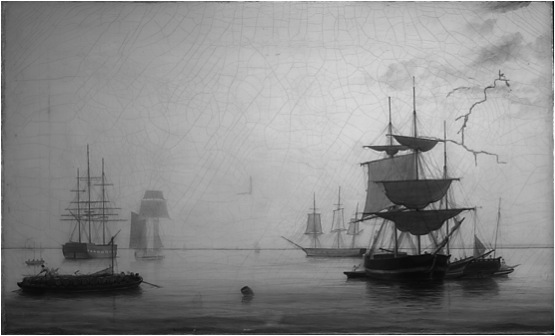
Harbor of Boston, with the City in the Distance, c.1846–47 (inv. 88) photographed using infrared reflectography. Oil on canvas, 17 x 27 in.
The Cleveland Museum of Art, Ohio, Leonard C. Hanna, Jr. Fund
and partial gift of Travers Newton, Joanna Newton Riccardi, and Georgia Newton Pulos (2004.35)
The Electromagnetic Spectrum
Electromagnetic radiation is a form of energy that travels through space in the form of waves that have both electric and magnetic field components. The electromagnetic spectrum comprises all possible regions of electromagnetic waves, each region falling within a specific range of frequencies and wavelengths. Waves with the highest frequency (highest energy) have the shortest wavelengths, and vice versa.
Visible light, which radiates at wavelengths between 400 and 700 nanometers, is the only portion of the electromagnetic spectrum that can be seen by the human eye. All other forms of radiant energy – radio waves, microwaves, infrared rays, ultraviolet radiation, x-rays, and gamma rays – are invisible to the naked eye.
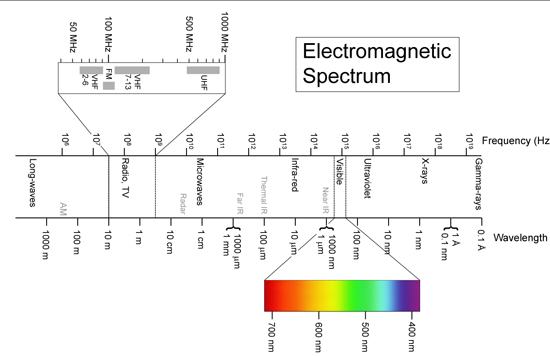
The Electromagnetic Spectrum
Visible Light
The evaluation of an object begins by an examination under conditions of visible light. The different wavelengths of visible light are perceived by the human eye as colors. In conservation, several types of photographic images are created to obtain as much information as possible regarding the surface characteristics of the object under study. To enhance certain features, the placement of the light source is usually changed with relation to the object.

The Visible Light Spectrum
Normal Light
When photographing under normal light, the object is evenly illuminated using identical light sources that are symmetrically placed in relation to the object. The goal is to illuminate the object strategically to avoid undesirable shadows or specular reflections that would distort the image. Ideally the light emanating from the source should contain all waves of visible light to avoid color distortions. For photographic purposes, a white balance is used to produce consistency of color and gray values in photographs of the same object in order to make precise comparisons.
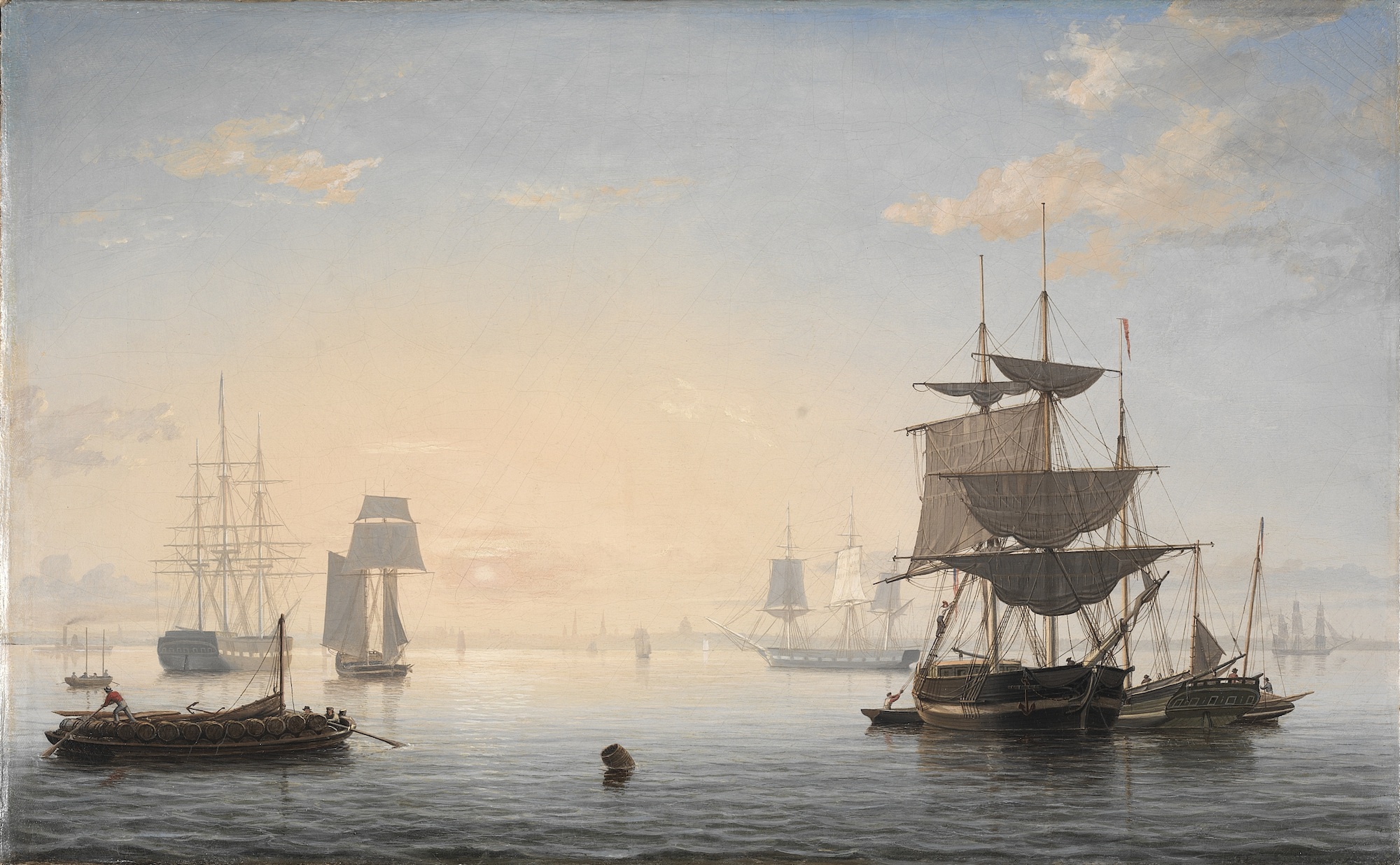
Harbor of Boston, with the City in the Distance, c.1846–47 (inv. 88) viewed under normal conditions. Oil on canvas, 17 x 27 in.
The Cleveland Museum of Art, Ohio, Leonard C. Hanna, Jr. Fund
and partial gift of Travers Newton, Joanna Newton Riccardi, and Georgia Newton Pulos (2004.35)
Ultraviolet Radiation (UV)
Ultraviolet Radiation (UV), the portion of the electromagnetic spectrum ranging from 100 to 400 nanometers, is next to the violet end of visible light and the X-ray region. Although this form of radiation is not visible to humans, conservators use lamps that emit UV energy that hits the surface of the object and is transformed into visible colors. These colors display identifiable characteristics and are known as ultraviolet-induced visible fluorescence. Whether fluorescence occurs, as well as its color, depends on the material under UV illumination. Certain compounds present in varnish resins and oils are reactive to UV radiation and produce visible fluorescence. Aged natural resin varnishes typically appear as a yellow-green haze over the surface of a painting while synthetic varnishes may appear milky white to purple. Compounds that contain linseed oil usually appear as a bluish haze. Newer restoration fluoresces much less brightly or not at all, and generally appears dark violet or black in comparison to original paint and varnish. Some pigments fluoresce with characteristic colors that can help identify the paint.
Note in this photograph the dark violet blemishes in center and right sky, as well as along the vertical edges. These are areas of retouching or non-original paint from past restoration of places where the painting was damaged.
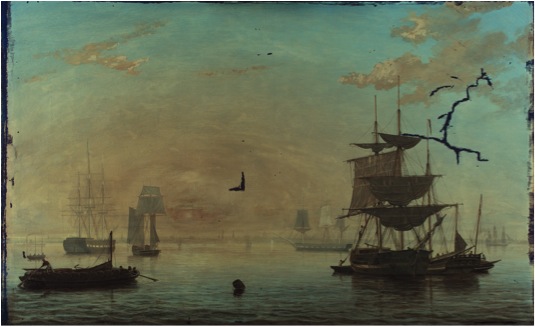
Harbor of Boston, with the City in the Distance, c.1846–47 (inv. 88) photographed with ultra-violet light
Raking Light
Raking Light is an illumination technique that uses a single source of visible light directed at a low angle to accentuate the surface characteristics of an artwork. This simple, yet effective, technique is particularly helpful in assessing the structural stability of the paint and ground layers. Slight surface anomalies that sometimes are not easily discernible – such as lifting paint or even past restoration – are enhanced by the contrast of light and shadow. Note in this photograph how the cracks in the paint layer are more visible in this extreme light.
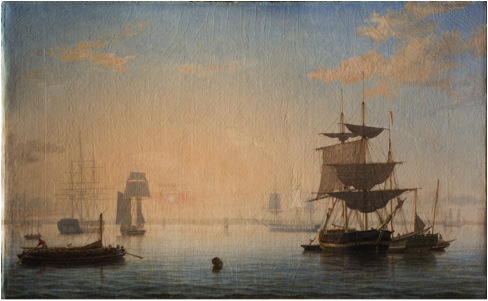
Harbor of Boston, with the City in the Distance, c.1846–47 (inv. 88) photographed with raking light
X-Radiography
X-Rays are a form of electromagnetic radiation with very short wavelengths and higher frequency than UV rays. This type of radiant energy can penetrate solids to varying degrees depending on the density and composition of the object. The denser the material, the more difficult it is to penetrate the object with X-rays. X- rays can be recorded on photographic film; the resulting image is called an X-Radiograph.
This X-radiograph illustrates the underlying modeling or application of paints based on their density. In particular, we can see how strokes of paint follow a curved pattern in the sky, whereas the brush-stroke patterns in the water and boats are more linear and smoother. The clouds, sun and white sails appear lighter in the X-radiograph because they contain elements with higher atomic weight, such as lead white, which block the X-rays. The wooden stretcher and nails holding the canvas to the stretcher are also visible around the perimeter.
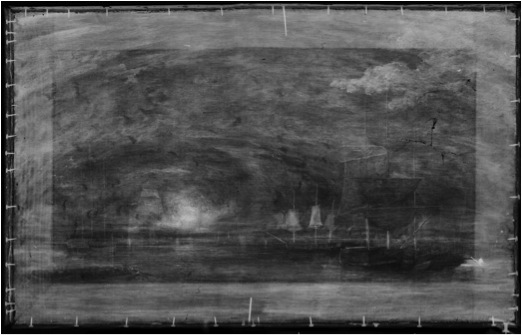
X-ray photograph of Harbor of Boston, with the City in the Distance, c.1846–47 (inv. 88)
Transmitted Light
When a painting is viewed with a light shining through from behind it, we see it in transmitted light. This type of examination requires that the painting be done on canvas and not have any type of added solid support, which would prevent the light from penetrating the painting from the reverse. Above and below are details of transmitted light and normal light from the painting of Boston Harbor at the Museum of Fine Arts in Boston. They reveal Lane’s method of scoring into the ground layer for the rigging and using fine pin pricks to place the masts and sails. Lane may have used the pins to anchor the straight lines used for the masts.

Transmitted light X-ray photograph of Boston Harbor, c.1850 (inv. 48) (detail) above and normal light below. Oil on canvas, 26 x 42 in.
Museum of Fine Arts, Boston, M. and M. Karolik Collection of American Paintings, 1815–1865, by exchange (66.339)
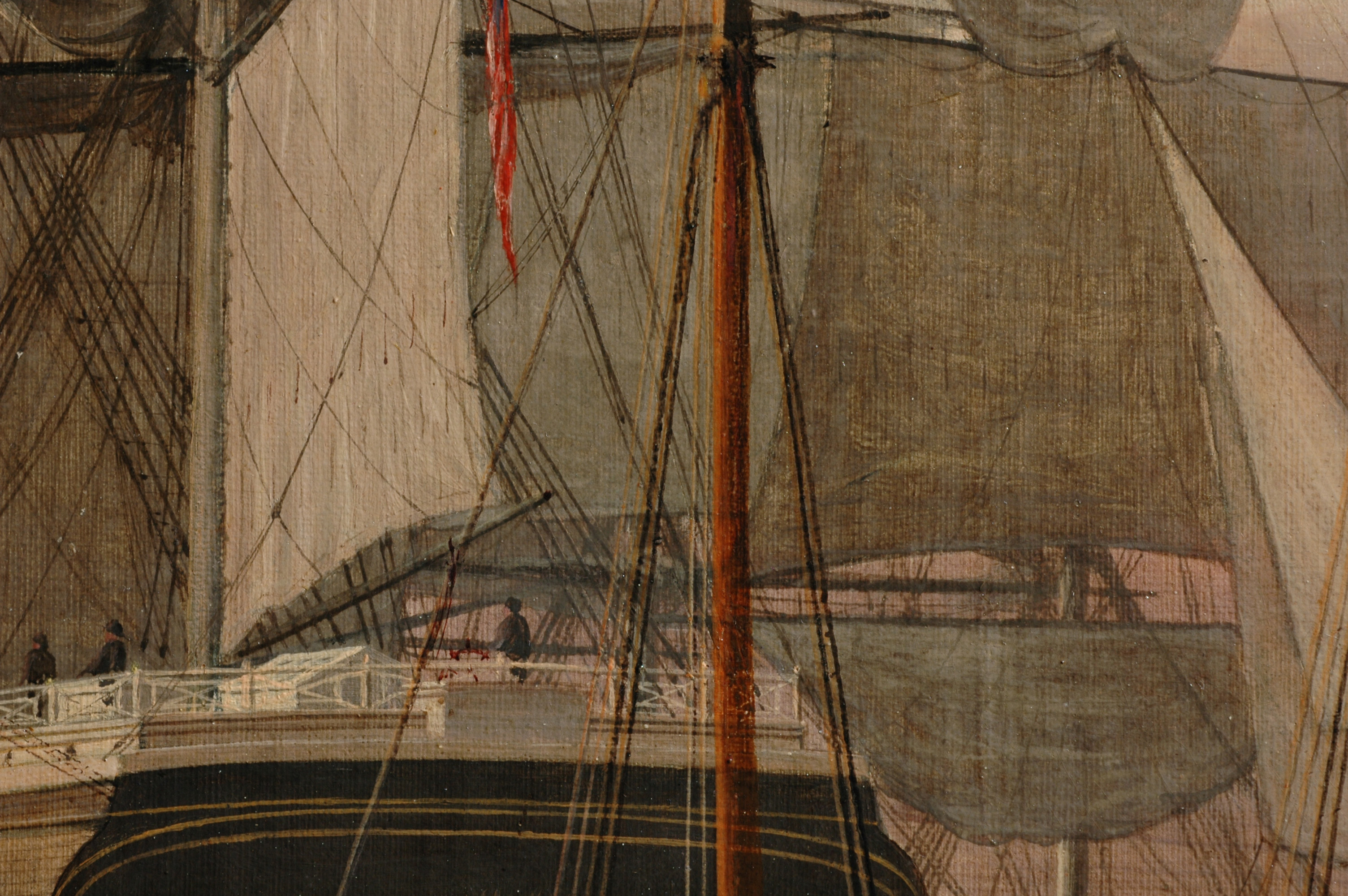

Detail of more pinpricks Lane used for masts and sails in X-ray photograph of Boston Harbor, c.1850 (inv. 48)
Specular Reflected Light
Specular Reflection is a lighting technique in which the light directed at the object is reflected back from the surface at almost the same angle of incidence. Note in this photographic image of specular reflection that certain features of the surface texture become more apparent, such as the thickness of the sails, and the smooth application of paint in the sky.
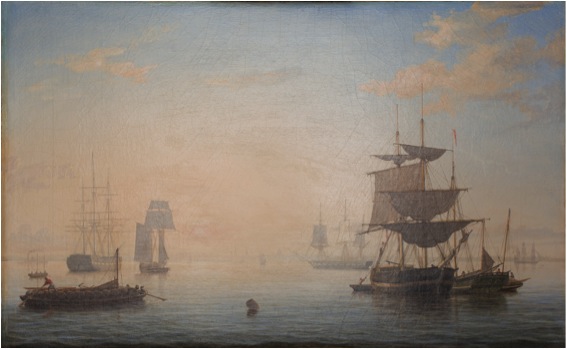
Harbor of Boston, with the City in the Distance, c.1846–47 (inv. 88) photographed using specular reflection
Infrared Reflectography (IRR)
Infrared (IR) radiation is the region of electromagnetic energy with wavelengths slightly longer than the visible spectrum. The term “infra-red” is used because this type of energy falls below the red end of visible light, next to the microwave region.
Infrared energy can penetrate deeper into the structure of a painting than visible light. When radiating a painting with IR energy, certain materials appear transparent while others– such as the carbon-based compounds– absorb the energy entirely and appear black. Usually the white color of the underlying preparation layer is reflected back, creating sharp contrast with dark areas of energy absorption. Using an infrared-sensitive camera, conservators can capture the light this is reflected off, the painting. The resulting image, or infrared reflectogram (IRR), is processed by a computer to generate a black-and-white image of the inner structure of the painting.
Infrared reflectography is especially valuable for studying the preliminary drawing as it was laid out with charcoal or graphite before any paint application. Pentimenti, changes in design and hidden signatures can also be revealed. In this particular image of Lane’s painting of Boston Harbor, the underdrawing of the sails and horizon line are clearly visible. Some of the figures in the boat in the left foreground were shifted from their original positions. A faint indication of a buoy is visible to the left of the barrel in the center foreground, but is not seen in the final painting. The ghostlike appearance of the smaller sailboat at left indicates there was no underdrawing and that it was added over the background paint.

Harbor of Boston, with the City in the Distance, c.1846–47 (inv. 88) photographed using infrared reflectography